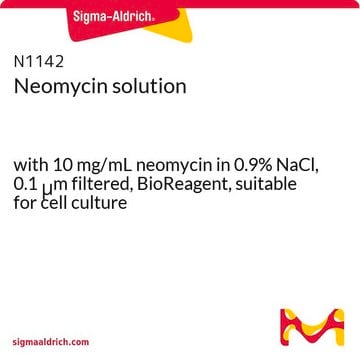345810
G 418 Sulfate, Cell Culture Tested
G418 also known as Geneticin is an aminoglycoside antibiotic related to Gentamicin. Used as a selective agent in transfection of eukaryotic cells. Has highest potency ≥730 µg/mg and purity ≥98%.
Sinonimo/i:
G 418 Sulfate, Cell Culture Tested, G418, G 418, NMD Inhibitor I
About This Item
Prodotti consigliati
Livello qualitativo
Saggio
≥98% (TLC)
Forma fisica
powder
Produttore/marchio commerciale
Calbiochem®
Condizioni di stoccaggio
OK to freeze
Impurezze
≤1.0% Ammonia
Colore
white
Solubilità
water: 100 mg/mL, clear, colorless
Cationi in tracce
heavy metals: ≤100 ppm
Condizioni di spedizione
ambient
Temperatura di conservazione
10-30°C
InChI
1S/C20H40N4O10.2H2O4S/c1-6(25)14-11(27)10(26)9(23)18(32-14)33-15-7(21)4-8(22)16(12(15)28)34-19-13(29)17(24-3)20(2,30)5-31-19;2*1-5(2,3)4/h6-19,24-30H,4-5,21-23H2,1-3H3;2*(H2,1,2,3,4)/t6?,7-,8+,9+,10+,11-,12-,13-,14+,15+,16-,17-,18+,19-,20+;;/m0../s1
UHEPSJJJMTWUCP-NKCAIAFTSA-N
Descrizione generale
Attenzione
Ricostituzione
Note legali
Avvertenze
Danger
Indicazioni di pericolo
Consigli di prudenza
Classi di pericolo
Resp. Sens. 1 - Skin Sens. 1
Codice della classe di stoccaggio
12 - Non Combustible Liquids
Classe di pericolosità dell'acqua (WGK)
WGK 3
Punto d’infiammabilità (°F)
Not applicable
Punto d’infiammabilità (°C)
Not applicable
Certificati d'analisi (COA)
Cerca il Certificati d'analisi (COA) digitando il numero di lotto/batch corrispondente. I numeri di lotto o di batch sono stampati sull'etichetta dei prodotti dopo la parola ‘Lotto’ o ‘Batch’.
Possiedi già questo prodotto?
I documenti relativi ai prodotti acquistati recentemente sono disponibili nell’Archivio dei documenti.
Articoli
Antibiotic kill curve is a dose response experiment in which mammalian cells are subjected to increasing amounts of selection antibiotic
Il team dei nostri ricercatori vanta grande esperienza in tutte le aree della ricerca quali Life Science, scienza dei materiali, sintesi chimica, cromatografia, discipline analitiche, ecc..
Contatta l'Assistenza Tecnica.




